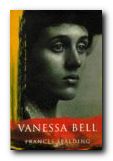Bloomsbury painter, matriarch, and bohemian
Vanessa Bell is best known as the sister of Virginia Woolf, but she was a distinguished artist in her own right, and her reputation has risen in recent years, along with other women artists such as Dora Carrington and Gwen John. Her father Leslie Stephen was a literary figure (editor of the Dictionary of National Biography but he encouraged Vanessa’s early enthusiasm for painting and drawing, and in 1901 she entered to study at the Royal Academy. Then following her father’s death she moved with her sister Virginia and their younger brother Adrian to live in Gordon Square.
 When their elder brother Thoby brought home his friends Lytton Strachey, Leonard Woolf and Saxon Sydney-Turner from Cambridge, it was there that the Bloomsbury Group began. She married Clive Bell in 1906 and achieved what seemed like immediate happiness with him – yet within two years she was completely taken up with her son Julian, and Clive had resumed an affair with his previous lover Mrs Craven-Hill.
When their elder brother Thoby brought home his friends Lytton Strachey, Leonard Woolf and Saxon Sydney-Turner from Cambridge, it was there that the Bloomsbury Group began. She married Clive Bell in 1906 and achieved what seemed like immediate happiness with him – yet within two years she was completely taken up with her son Julian, and Clive had resumed an affair with his previous lover Mrs Craven-Hill.
As a biographer, Frances Spalding is frank and explicit regarding the behaviour of secondary characters, but she protects her principal subject behind a smokescreen of evasion and omission. Even though she documents the movements and actions of her characters on what is often a day-to-day basis, Vanessa has been engaged in a sexual relationship with Roger Fry for several months before it is even mentioned, and then obliquely, as if it is solely his decision:
Roger Fry was still legally married. Discretion necessarily surrounded his affair with Vanessa which at first was kept from Clive
She is on much stronger ground when discussing the development of Vanessa Bell’s painting. The influence of Roger Fry, the Post-Impressionists, and her exposure to French art (Gaugin, Derain, Picasso, Braque) are traced quite intelligently and linked well to the illustrations in the book which have been selected to represent some of her most important works.
Despite Frances Spalding’s efforts to turn her into a saint, Vanessa Bell emerges as a fairly scheming egoist – quite content to keep both the legal and sexual connection with her husband intact, whilst developing her affair with Roger Fry, then replacing him with Duncan Grant, and keeping all three in her orbit – which Spalding interprets as an example of generosity of spirit. On their part maybe, but on hers?
When Duncan Grant (who was a homosexual) makes her pregnant, the resulting child (Angelica) is passed off as Clive Bell’s for the sake of propriety and probably economics (given the amount of money which Bell’s family was pumping into hers). It was something which had fairly dire consequences for the girl, as she documents in her own version of events, Deceived with Kindness. But all this is passed over with very little comment.
Despite all the bohemianism, everything is based on a foundation of rock-solid middle-class economics: multiple property ownerships; a permanent retinue of servants (cook, housemaid, nurse, housekeeper); and stock-market investments carefully managed by John Maynard Keynes. Since he was at the time was an advisor to the Treasury, this is something we would today call insider trading. It’s is a world where bells (not Bells) rang at one for lunch, five for tea, and dinner at eight.
In the 1920s and 1930s Vanessa divided her time between Charleston (the much decorated house that she shared with Duncan Grant) and Cassis in France, where she helped to popularise the Cote d’Azur amongst artists. Her exhibitions were quite successful, and she had commissions for decorative work.
It’s often said that she retreated into a reclusive lifestyle at this time, but she flits from Paris to Rome, and back to London and Sussex at a dizzying rate, and Spalding’s pages are dense with the names of writers, artists, and upper-class socialites, plus Duncan Grant’s gay hangers-on (who presented a constant threat to their partnership).
Then there comes a period of personal loss: the death of Lytton Strachey, followed by Roger Fry, and most damaging of all her son Julian (killed in the Spanish Civil War) and her sister Virginia’s suicide. Further losses were sustained in the post-war years, but she continued to paint and complete decorative commissions.
But the later years of her life were dominated by her pleasure at being a grandparent [always much easier than being a parent] and though she became something of an establishment figure (sitting on artistic committees) her retreat in the last two decades of her life was into the pleasures of what was left of her family and friends.
Despite my reservations about the picture created here, this is a thorough and a scholarly biography, with all its sources fully documented. It’s simultaneously the complete account of a life, a rich documentary on the Bloomsbury Group, and a historical account which begins in the Victorian era and ends in modern post-war Britain.
© Roy Johnson 2002
Frances Spalding, Vanessa Bell, London: Macmillan, 1987, pp.399, ISBN 0333372255
More on biography
More on the Bloomsbury Group
Twentieth century literature